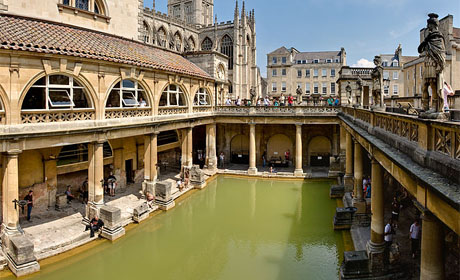Bath Spa
Somerset, England

Thermal Hot Springs
There are many small thermal (hot) and mineral springs in the UK. Well-known examples include those in Bath, Buxton and Harrogate. Bathing in these waters was popular amongst fashionable society in the seventeenth and eighteenth centuries, as it was considered beneficial to health. The practice continued into the nineteenth century but declined after that in the UK.
Thermal springs are a natural phenomenon which occur where hot water from great depths in the Earth rises to the surface. In the UK, groundwater normally has a temperature around 10-12oC and reflects the average annual air temperature. Shallow springs therefore have a similar temperature. As you go deeper underground the temperature increases due to heat stored in the earth, originating from when the Earth was formed and from radioactive decay of minerals. This is known as the geothermal gradient. Subsurface temperature generally increases by 26° C for every kilometre increase in depth, but this varies locally depending on the thermal conductivity of the rock. As the temperature of the earth increases with depth, so too does the temperature of the groundwater.
The source and travel path of groundwater to springs differs and as a result the nature of the water that issues from the spring is very different.
The Bath Hot Springs

The Bath Hot Springs rise in the centre of the city of Bath in Somerset. Around 1.3 million litres of water flow from the springs every day at a temperature of around 40 °C. There is some debate about the source of the water but the generally accepted hypothesis is that rain water falling on the Mendip Hills to the south of the city infiltrates the Carboniferous Limestone and flows to the north, beneath the North Somerset coal field reaching a depth of 2.5 km from where it obtains its heat. It then rises up through fractures in the Jurassic rocks beneath the city. The chemistry of the water is dominated by calcium and sulphate with sodium and chloride also in high concentration.
There are three separate springs in Bath, the largest and most significant is the King’s Spring which rises within the Roman Baths Museum. The smaller Hetling Spring and Cross Bath Spring are located approximately 150 m to the west of the King’s Spring. The thermal spring water emerges from funnel-shaped gravel deposits under the city. Each spring is tapped at depth by a borehole, which draws water from below the shallow gravel deposits to deliver clean thermal water to the drinking fountain in the Roman Baths museum and the local spa complex.
Text and Image courtesy of the UK Groundwater Forum, for more information on thermal springs in the UK, see their website.
Nominated by: Selection Committee